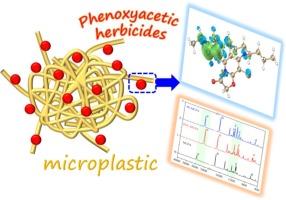微塑料吸附除草剂的分子机制研究:量子化学方法
IF 8
1区 环境科学与生态学
Q1 ENVIRONMENTAL SCIENCES
引用次数: 0
摘要
微塑料在环境中的广泛存在引起了极大的关注,特别是它们与除草剂的潜在相互作用以及对生态系统的综合污染影响。本研究采用量子化学计算方法研究了聚乙烯(PE)和聚氯乙烯(PVC)微塑料与苯氧乙酸除草剂的相互作用机理。结果表明,与PE相比,PVC具有更强的吸附能力,低离子强度条件减弱了微塑料与除草剂的相互作用。能量分解分析表明,分散和静电相互作用是贡献相互作用能的主要成分,从而将除草剂在微塑料上的吸附位点定位在范德华电位和静电电位的最小值附近。微塑料中氢键受体的存在影响了除草剂与羧基分子内或分子间氢键的形成,导致振动模式和红外光谱吸收峰发生显著变化,为微塑料对除草剂的吸附提供了一种潜在的原位监测方法。此外,在吸附过程中观察到不同的电荷转移现象,PVC倾向于失去电子,PE倾向于获得电子。这些发现为深入了解苯氧乙酸除草剂对微塑料的吸附行为提供了理论基础,并对环境修复策略的优化具有重要意义。本文章由计算机程序翻译,如有差异,请以英文原文为准。

Exploring the molecular mechanisms of herbicide adsorption on microplastics: A quantum chemical approach
The widespread presence of microplastics in the environment has raised significant concerns, particularly regarding their potential interactions with herbicides and the combined pollution effects on ecosystems. In this study, quantum chemical calculations were employed to investigate the interaction mechanisms between polyethylene (PE) and polyvinyl chloride (PVC) microplastics and phenoxyacetic herbicides. The results revealed that PVC exhibits a stronger adsorption capacity compared to PE, and that low ionic strength conditions weaken the interactions between microplastics and herbicides. The energy decomposition analysis indicates that dispersion and electrostatic interactions are the predominant components contributing to the interaction energy, thus positioning the herbicide adsorption sites on microplastics near the minima of van der Waals and electrostatic potentials. The presence of hydrogen bond acceptors in microplastics influences the formation of intramolecular or intermolecular hydrogen bonds with the carboxylic groups of herbicides, resulting in significant changes in vibrational modes and infrared spectral absorption peaks, which offers a potential method for in situ monitoring of herbicide adsorption on microplastics. Additionally, different charge transfer phenomena are observed during the adsorption process, with PVC tending to lose electrons and PE to gain electrons. These insights provide a theoretical foundation for a deeper understanding of the adsorption behavior of phenoxyacetic herbicides on microplastics and hold significant implications for the optimization of environmental remediation strategies.
求助全文
通过发布文献求助,成功后即可免费获取论文全文。
去求助
来源期刊

Science of the Total Environment
环境科学-环境科学
CiteScore
17.60
自引率
10.20%
发文量
8726
审稿时长
2.4 months
期刊介绍:
The Science of the Total Environment is an international journal dedicated to scientific research on the environment and its interaction with humanity. It covers a wide range of disciplines and seeks to publish innovative, hypothesis-driven, and impactful research that explores the entire environment, including the atmosphere, lithosphere, hydrosphere, biosphere, and anthroposphere.
The journal's updated Aims & Scope emphasizes the importance of interdisciplinary environmental research with broad impact. Priority is given to studies that advance fundamental understanding and explore the interconnectedness of multiple environmental spheres. Field studies are preferred, while laboratory experiments must demonstrate significant methodological advancements or mechanistic insights with direct relevance to the environment.
 求助内容:
求助内容: 应助结果提醒方式:
应助结果提醒方式:


